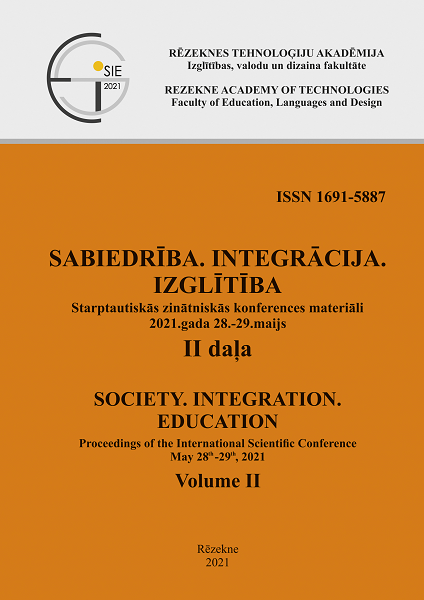IMPORTANT FACTORS FOR MORE EFFECTIVE LEARNING OF MATHEMATICS
DOI:
https://doi.org/10.17770/sie2021vol2.6466Keywords:
Artificial Intelligence, Distance Learning, Interdisciplinary Approaches, MathematicsAbstract
Mathematics is an important and complex subject, and research in the field of neuroscience shows that 50% of people have a fear of mathematics. However, it is a subject that students will need for the rest of their lives. Educators recognize that every student needs an individual approach, but the teaching methods are still the same for the whole class. The poor results in mathematics also suggest that students' perceptions and interests have changed, and that old teaching methods are no longer as effective as before and that new solutions need to be invented. The aim of the research is to identify important factors that are necessary for more effective learning of mathematics in general education schools. Qualitative research methods were used for the research strategy - in-depth interviews, focus group discussions, surveys of pupils and students, information analysis in the media, pedagogical and business experience, as well as world success stories. As a result of the research, the following have been identified: 1) problems that were identified using the distance learning during the Covid19 pandemic; 2) students' wishes that arouse interest in mathematics; 3) the interests of students, which indicate the need for interdisciplinary approaches; 4) advantages of artificial intelligence (AI) in education. The study points to the necessity for collaboration between educators, industry professionals, entrepreneurs and researchers, and for AI solutions to create deeper, faster and more personalized learning of mathematics in general education schools in the future, increasing the growth of every student.
References
Accenture. (2018). IT`S LEARNING. JUST NOT AS WE KNOW IT. How to accelerate skills acquisition in the age of intelligent technologies. Retrieved from URL https:// www.accenture.com/_acnmedia/thought-leadership-assets/pdf/accenture-education-and-technology-skills-research.pdf
Akmene, Z. (2020). Ja es būtu 'skolēns 2' jeb attālināto mācību plāns nemotivētiem skolēniem. Delfi. Retrieved from https://www.delfi.lv/news/versijas/zane-akmene-ja-es-butu-skolens-2-jeb-attalinato-macibu-plans-nemotivetiem-skoleniem.d?id=52056193
AldertKampAdvies. (2017). Interdisciplinary education: a wave of the fiture? Retrieved from https://www.aldertkamp.nl/post/interdisciplinary-education-a-wave-of-the-future
Arāja, M. (2020). Matemātikas popularizēšanai izveido digitālo izlaušanās spēli. LA.LV. Retrieved from https://www.la.lv/matematikas-popularizesanai-izveido-digitalo-izlausanas-speli
Bidshahri, R. (2017). Neuroeducation Will Lead to Big Breakthroughs in Learning. https://singularityhub.com/2017/10/24/neuroeducation-will-lead-to-big-breakthroughs-in-learning/
Binde, J. (2020). No industrijas 4.0 uz izglītību 4.0. Delfi. Retrieved from https://www.delfi.lv/news/versijas/juris-binde-no-industrijas-40-uz-izglitibu-40.d?id=52606769
Boaler, J. (2016) Mathematical Mindsets: Unleashing Students’ Potential through Creative Math, Inspiring Messages and Innovative Teaching. Jossey-Bass/Wiley: Chappaqua, NY.
Boaler, J. (2019). Limitless mind. Learn, lead and live without barriers. CPI Group (UK) Ltd, Croydon. 248 pp.
Coyle, D. (2009). The Talent Code: Greatness Isn’t Born, It’s Grown, Here’s How. New York: Bantam Books.
Duval, A. (2019). Everyone Can Learn Mathematics to High Levels: The Evidence from Neuroscience that Should Change our Teaching. AMS Blogs. On Teaching and Learning Mathematics. Posted on February 1, 2019.
Eurydice. (2011). Mathematic in Europe: Common Challenges and National Policies. Education, Audiovisual and Culture Executive Agency.
Guo, T., Han, C. (2020). Artificial intelligence mechanism and mathematics implementation methods. Scientia Sinica Mathematica. Volume 50, Issue 11, November 2020, pp 1541-1578.
IZM. (2020). Mācību gada noslēguma aptaujas IZM un Edurio aptauju rezultāti. Retrieved from https://home.edurio.com/izm-gada-nosleguma-aptaujas
IZM, & LU. (2019). Latvija OECD Starptautiskajā skolēnu novērtēšanas programmā PISA 2018 – pirmie rezultāti un secinājumi. Retrieved from https://www.izm.gov.lv/images/aktualitates/ 2019/OECD_PISA_2018.pdf
John, S. (2018). Major Benefits of Artificial Intelligence in Education. Retrieved from https://wittysparks.com/major-benefits-of-artificial-intelligence-in-education/
Karsenti, T. (2019). Artificial intelligence in education: The urgent need to prepare teachers for tomorrow’s schools. Formation et profession 27(1), pp.104-111.
Kim, E. (2020). The Case for Interdisciplinary Education: A Student’s Perspective. Njcssjournal. Social studies. Retrieved from https://teachingsocialstudies.org/2020/08/15/the-case-for-interdisciplinary-education-a-students-perspective/
Kiryakova, G. (2009). Review of distance education. Trakia University, Trakia Journal of Sciences, Vol. 7, No. 3, pp. 29-34, 2009.
Kuprenko, V. (2020). Artificial Intelligence in Education: Benefits, Challenges, and Use Cases. All You Need to Know About AI in Education. Retrieved from https://medium.com/towards-artificial-intelligence/artificial-intelligence-in-education-benefits-challenges-and-use-cases-db52d8921f7a
Maguire, E. A., Gadian, D. G., Johnsrude, I. S., Good, C. D., Ashburner, J., Frackowiak, R. S., & Frith, C. D. (2000). Navigation-related structural change in the hippocampi of taxi drivers. Proceedings of the National Academy of Sciences, 97(8), 4398-4403.
Menon, V. (2015). Salience Network. In: Arthur W. Toga, editor. Brain Mapping: An Encyclopedic Reference, vol. 2, pp. 597-611. Academic Press: Elsevier.
Moe, M., Rajendran, V. (2020). Dawn of the Age of Digital Learning. An Acceleration of Trends That Have Been Building for Years. Published online: 6 May 2020. Retrieved from https://medium.com/gsv-ventures/dawn-of-the-age-of-digital-learning-4c4e38784226
Perera, M., Aboal, D. (2019). The Impact of a Mathematics Computer-Assisted Learning Platform on Students’ Mathematics Test Scores. Maastricht Economic and social Research institute on Innovation and Technology (UNU-MERIT).
Rātfelders, T. (2020). Šuplinska: Izbrīna, ka daudziem studentiem un skolotājiem ir ļoti novecojusi datortehnika. Retrieved from https://www.tvnet.lv/6939491/suplinska-izbrina-ka-daudziem-studentiem-un-skolotajiem-ir-loti-novecojusi-datortehnika
Rozenberga, M. (2020). Vai “plaģiātu vīruss”? Attālinātajās mācībās skolas novēro mēģinājumus šmaukties ar uzdevumiem. LSM, Published online: 8 May 2020. Retrieved from https://www.lsm.lv/raksts/zinas/latvija/vai-plagiatu-viruss-attalinatajas-macibas-skolas-novero-meginajumus-smaukties-ar-uzdevumiem.a359003/
Sadeghi, M. (2019). A Shift from Classroom to Distance Learning: Advantages and Limitations. International Journal of Research in English Education (IJREE), Published online: 20 March 2019.
Southgate, E., Blackmore, K., Pieschl, S., Grimes, S., McGuire, J., Smithers, K. (2019). Artificial Intelligence and Emerging Technologies in Schools. Research Report, Commissioned by the Australian Government Department of Education.
Terada, Y. (2020). 7 High-Impact, Evidence-Based Tips for Online Teaching. Edutopia, Published online: 9 October 2020, Retrieved from URL https://www.edutopia.org/article/7-high-impact-evidence-based-tips-online-teaching
UNESCO Education Sector. (2019). Artificial Intelligence in Education: Challenges and Opportunities for Sustainable Development. Education 2030. Working Papers on Education Policy.
ViewSonic. (2020). What Is Distance Learning? And Why Is It So Important? ViewSonic Library, Published online: 10 Marh 2020. Retrieved from https://www.viewsonic.com/library/education/what-is-distance-learning-and-why-is-it-so-important/
Vlassenko, L., Bozhok, N. (2014). Advantages and disadvantages of distance learning. National University of Food Technologies, Ukraine, 2014.
Wilson, D. & Conyers, M. (2013). Five Big Ideas for Effective Teaching: Connecting Mind, Brain, and Education Research to Classroom Practice. New York: Teachers College Press.






